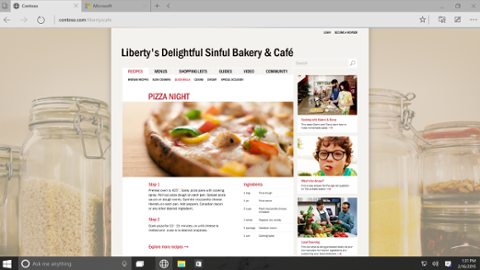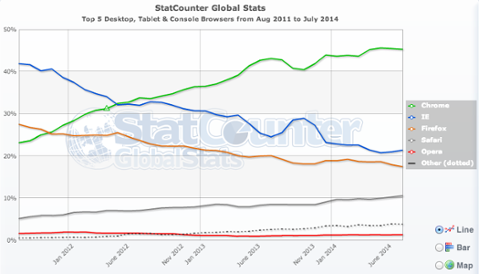 [/caption] A Web browser is a fundamental aspect of many cloud services, not to mention a pretty good way for a company like Google or Microsoft to spread its brand a little further among millions of people (sometimes a little too far, as some antitrust actions can attest). Browsers’ symbiotic relationship with cloud apps makes the issue of browser market-share a vital one. And the latest data from StatCounter suggests that Google has a bit of an upper hand, with its Chrome browser holding some 32.76 percent of the global market, just ahead of Microsoft’s Internet Explorer at 31.94 percent. Firefox came in third, with 25.47 percent, followed by Safari with 7.08 percent and Opera with 1.74 percent. The data’s reporting period ended May 20. But other analytics firms paint a radically different story. Net Applications, for instance, places Internet Explorer’s combined share at 54.09 percent, followed by Firefox at 20.20 percent, Chrome at 18.85 percent, Safari at 4.81 percent and Opera at 1.63 percent. Methodologies obviously differ between research firms, with some (such as Net Applications) relying on unique visits instead of page views (in the case of StatCounter). Net Applications also “geoweights” its data, meaning that it adjusts its traffic vis-à-vis the info posted on the CIA Internet Traffic by Country table, ostensibly in the name of balancing out data between markets. However predictably, Microsoft took to the blogosphere to trump Net Applications’ data over that of StatCounter. “We used the public CIA country data for this analysis,” Roger Capriotti, director of Internet Explorer Product Marketing, wrote in a May 18 posting on the official Internet Explorer blog. “You could of course use other data sources available to you to account for real world Internet population, but however you look at this, the discrepancy in numbers is substantial.” Browsers can add functionality to specific cloud apps; for example, Google allows Chrome users to upload folders wholesale to Google Docs, without needing to install a small applet. And of course, different browsers come with different security and navigation features, which must be vetted by IT administrators before workers can use them for cloud apps. Image: StatCounter
[/caption] A Web browser is a fundamental aspect of many cloud services, not to mention a pretty good way for a company like Google or Microsoft to spread its brand a little further among millions of people (sometimes a little too far, as some antitrust actions can attest). Browsers’ symbiotic relationship with cloud apps makes the issue of browser market-share a vital one. And the latest data from StatCounter suggests that Google has a bit of an upper hand, with its Chrome browser holding some 32.76 percent of the global market, just ahead of Microsoft’s Internet Explorer at 31.94 percent. Firefox came in third, with 25.47 percent, followed by Safari with 7.08 percent and Opera with 1.74 percent. The data’s reporting period ended May 20. But other analytics firms paint a radically different story. Net Applications, for instance, places Internet Explorer’s combined share at 54.09 percent, followed by Firefox at 20.20 percent, Chrome at 18.85 percent, Safari at 4.81 percent and Opera at 1.63 percent. Methodologies obviously differ between research firms, with some (such as Net Applications) relying on unique visits instead of page views (in the case of StatCounter). Net Applications also “geoweights” its data, meaning that it adjusts its traffic vis-à-vis the info posted on the CIA Internet Traffic by Country table, ostensibly in the name of balancing out data between markets. However predictably, Microsoft took to the blogosphere to trump Net Applications’ data over that of StatCounter. “We used the public CIA country data for this analysis,” Roger Capriotti, director of Internet Explorer Product Marketing, wrote in a May 18 posting on the official Internet Explorer blog. “You could of course use other data sources available to you to account for real world Internet population, but however you look at this, the discrepancy in numbers is substantial.” Browsers can add functionality to specific cloud apps; for example, Google allows Chrome users to upload folders wholesale to Google Docs, without needing to install a small applet. And of course, different browsers come with different security and navigation features, which must be vetted by IT administrators before workers can use them for cloud apps. Image: StatCounter Chrome Battles Internet Explorer for Browser Market Lead
[caption id="attachment_1102" align="aligncenter" width="618" caption="This graph is practically giving Microsoft's IE team a collective aneurism."]  [/caption] A Web browser is a fundamental aspect of many cloud services, not to mention a pretty good way for a company like Google or Microsoft to spread its brand a little further among millions of people (sometimes a little too far, as some antitrust actions can attest). Browsers’ symbiotic relationship with cloud apps makes the issue of browser market-share a vital one. And the latest data from StatCounter suggests that Google has a bit of an upper hand, with its Chrome browser holding some 32.76 percent of the global market, just ahead of Microsoft’s Internet Explorer at 31.94 percent. Firefox came in third, with 25.47 percent, followed by Safari with 7.08 percent and Opera with 1.74 percent. The data’s reporting period ended May 20. But other analytics firms paint a radically different story. Net Applications, for instance, places Internet Explorer’s combined share at 54.09 percent, followed by Firefox at 20.20 percent, Chrome at 18.85 percent, Safari at 4.81 percent and Opera at 1.63 percent. Methodologies obviously differ between research firms, with some (such as Net Applications) relying on unique visits instead of page views (in the case of StatCounter). Net Applications also “geoweights” its data, meaning that it adjusts its traffic vis-à-vis the info posted on the CIA Internet Traffic by Country table, ostensibly in the name of balancing out data between markets. However predictably, Microsoft took to the blogosphere to trump Net Applications’ data over that of StatCounter. “We used the public CIA country data for this analysis,” Roger Capriotti, director of Internet Explorer Product Marketing, wrote in a May 18 posting on the official Internet Explorer blog. “You could of course use other data sources available to you to account for real world Internet population, but however you look at this, the discrepancy in numbers is substantial.” Browsers can add functionality to specific cloud apps; for example, Google allows Chrome users to upload folders wholesale to Google Docs, without needing to install a small applet. And of course, different browsers come with different security and navigation features, which must be vetted by IT administrators before workers can use them for cloud apps. Image: StatCounter
[/caption] A Web browser is a fundamental aspect of many cloud services, not to mention a pretty good way for a company like Google or Microsoft to spread its brand a little further among millions of people (sometimes a little too far, as some antitrust actions can attest). Browsers’ symbiotic relationship with cloud apps makes the issue of browser market-share a vital one. And the latest data from StatCounter suggests that Google has a bit of an upper hand, with its Chrome browser holding some 32.76 percent of the global market, just ahead of Microsoft’s Internet Explorer at 31.94 percent. Firefox came in third, with 25.47 percent, followed by Safari with 7.08 percent and Opera with 1.74 percent. The data’s reporting period ended May 20. But other analytics firms paint a radically different story. Net Applications, for instance, places Internet Explorer’s combined share at 54.09 percent, followed by Firefox at 20.20 percent, Chrome at 18.85 percent, Safari at 4.81 percent and Opera at 1.63 percent. Methodologies obviously differ between research firms, with some (such as Net Applications) relying on unique visits instead of page views (in the case of StatCounter). Net Applications also “geoweights” its data, meaning that it adjusts its traffic vis-à-vis the info posted on the CIA Internet Traffic by Country table, ostensibly in the name of balancing out data between markets. However predictably, Microsoft took to the blogosphere to trump Net Applications’ data over that of StatCounter. “We used the public CIA country data for this analysis,” Roger Capriotti, director of Internet Explorer Product Marketing, wrote in a May 18 posting on the official Internet Explorer blog. “You could of course use other data sources available to you to account for real world Internet population, but however you look at this, the discrepancy in numbers is substantial.” Browsers can add functionality to specific cloud apps; for example, Google allows Chrome users to upload folders wholesale to Google Docs, without needing to install a small applet. And of course, different browsers come with different security and navigation features, which must be vetted by IT administrators before workers can use them for cloud apps. Image: StatCounter
 [/caption] A Web browser is a fundamental aspect of many cloud services, not to mention a pretty good way for a company like Google or Microsoft to spread its brand a little further among millions of people (sometimes a little too far, as some antitrust actions can attest). Browsers’ symbiotic relationship with cloud apps makes the issue of browser market-share a vital one. And the latest data from StatCounter suggests that Google has a bit of an upper hand, with its Chrome browser holding some 32.76 percent of the global market, just ahead of Microsoft’s Internet Explorer at 31.94 percent. Firefox came in third, with 25.47 percent, followed by Safari with 7.08 percent and Opera with 1.74 percent. The data’s reporting period ended May 20. But other analytics firms paint a radically different story. Net Applications, for instance, places Internet Explorer’s combined share at 54.09 percent, followed by Firefox at 20.20 percent, Chrome at 18.85 percent, Safari at 4.81 percent and Opera at 1.63 percent. Methodologies obviously differ between research firms, with some (such as Net Applications) relying on unique visits instead of page views (in the case of StatCounter). Net Applications also “geoweights” its data, meaning that it adjusts its traffic vis-à-vis the info posted on the CIA Internet Traffic by Country table, ostensibly in the name of balancing out data between markets. However predictably, Microsoft took to the blogosphere to trump Net Applications’ data over that of StatCounter. “We used the public CIA country data for this analysis,” Roger Capriotti, director of Internet Explorer Product Marketing, wrote in a May 18 posting on the official Internet Explorer blog. “You could of course use other data sources available to you to account for real world Internet population, but however you look at this, the discrepancy in numbers is substantial.” Browsers can add functionality to specific cloud apps; for example, Google allows Chrome users to upload folders wholesale to Google Docs, without needing to install a small applet. And of course, different browsers come with different security and navigation features, which must be vetted by IT administrators before workers can use them for cloud apps. Image: StatCounter
[/caption] A Web browser is a fundamental aspect of many cloud services, not to mention a pretty good way for a company like Google or Microsoft to spread its brand a little further among millions of people (sometimes a little too far, as some antitrust actions can attest). Browsers’ symbiotic relationship with cloud apps makes the issue of browser market-share a vital one. And the latest data from StatCounter suggests that Google has a bit of an upper hand, with its Chrome browser holding some 32.76 percent of the global market, just ahead of Microsoft’s Internet Explorer at 31.94 percent. Firefox came in third, with 25.47 percent, followed by Safari with 7.08 percent and Opera with 1.74 percent. The data’s reporting period ended May 20. But other analytics firms paint a radically different story. Net Applications, for instance, places Internet Explorer’s combined share at 54.09 percent, followed by Firefox at 20.20 percent, Chrome at 18.85 percent, Safari at 4.81 percent and Opera at 1.63 percent. Methodologies obviously differ between research firms, with some (such as Net Applications) relying on unique visits instead of page views (in the case of StatCounter). Net Applications also “geoweights” its data, meaning that it adjusts its traffic vis-à-vis the info posted on the CIA Internet Traffic by Country table, ostensibly in the name of balancing out data between markets. However predictably, Microsoft took to the blogosphere to trump Net Applications’ data over that of StatCounter. “We used the public CIA country data for this analysis,” Roger Capriotti, director of Internet Explorer Product Marketing, wrote in a May 18 posting on the official Internet Explorer blog. “You could of course use other data sources available to you to account for real world Internet population, but however you look at this, the discrepancy in numbers is substantial.” Browsers can add functionality to specific cloud apps; for example, Google allows Chrome users to upload folders wholesale to Google Docs, without needing to install a small applet. And of course, different browsers come with different security and navigation features, which must be vetted by IT administrators before workers can use them for cloud apps. Image: StatCounter 

